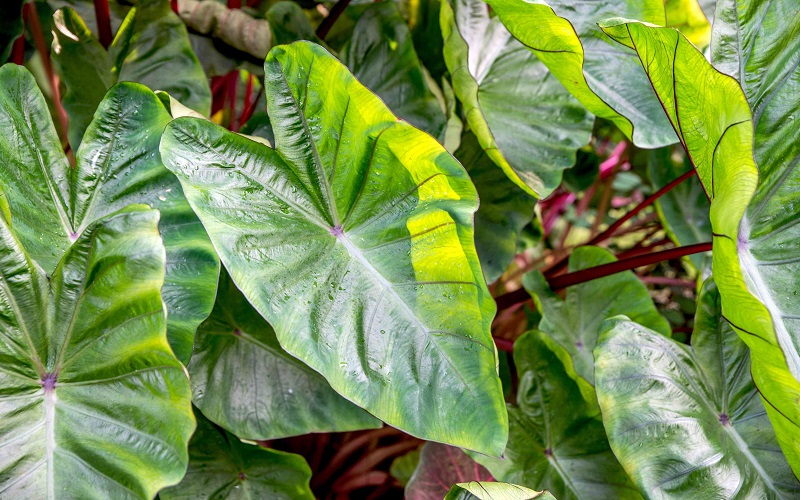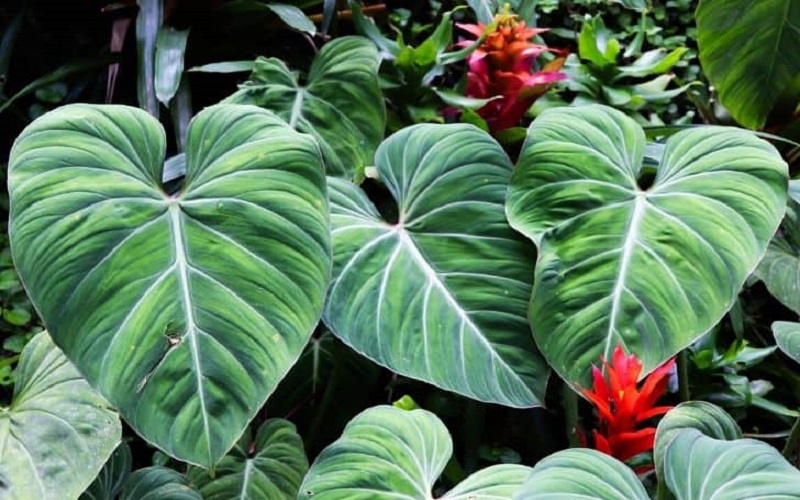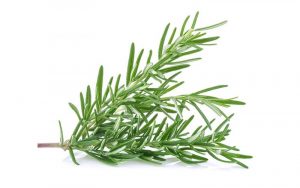People who are interested in gardening always look for something unique and exclusive for their garden. Nowadays, the most hyped topic about gardening is the plants that look like elephant ears as they eye appealing for the garden. By looking at those plants for the first time, people confused them with elephant ears as they are big in size and have arrow heart-shaped structures.
You will find different kinds of these types of species but the most common for them to grow in the tropical regions of Asia and the United States. It is easy to grow elephant ears plants if the gardening place gets enough sunlight and water.
Types of Elephant Ears Plants
There are different types of plants that look like elephant ears but the most common types are Colocasia and Alocasia. These two types have the biggest shaped leaves that are hard to differentiate from elephant ears. Another type that is mostly seen apart from Colocasia and Alocasia is Xanthosoma.
Xanthosoma has quite similar characteristics to Alocasia as their cultivation process is different. This species has a lower requirement of water than Colocasia and likes well-draining soil to grow. Now coming to the main types that are Colocasia and Alocasia, are similar in certain points but have many dissimilarities in the case of structure.
For Colocasia, they like to show the front part of their leaves by moving the tips of the leaves in a downward position. While it is different for Alocasia as they grow by taking the leaves at an upward position.
Check Out Top 3 Elephant Ear Plants:
- Hardy Zone 7-10. We are zone 6b, and find if we plant them...
- Foliage:Deciduous, Sunlight:Full Sun
- Season Of Interest:Summer
- Foliage: deciduous, sunlight: full sun
- Season of interest: summer
5 Plants That Look Like Elephant Ears
1. Colocasia

Having the ability to grow up to three feet in length, colocasia is a common type of species that are found in muddy regions in Asia. Colocasia is quite native in those areas of Asia where the environment is soggy and is quite famous for decoration purposes in gardens.
Moreover, three feet long is not the limit of this species as some of them can grow up to 8 feet tall. The main specialty of this plant that attracts people is its structure. The heart-shaped structure gives a vibe of elephant ears as they are too big in size. Also, the tip of this plant always grows by pointing downwards and displaying the upper parts of the leaves.
As they are common in swampy regions of Asia, they need compatible moisture and heat to grow. So, if you are planning to grow them in your garden, you have to keep them in such a place where it gets proper sunlight.
2. Alocasia

You can find elephant ears like structured leaves in the genus of Alocasia. This includes 70 species in its genus that have large leaves looking like huge elephant ears. Among the Alocasia genus, Giant taro which is also known as Alocasia macrorrhizos, is widely popular for the paste made from it. Also, this species is well-known for the length of the leaves that can grow up to 12 to 15 feet.
The most interesting point of the species Alocasia macrorrhizos is the width of the leaves. The blades of the leaves of this species can widen up to 2 to 5 feet. This is the reason people compare their leaves with elephant ears and choose them to grow in their garden.
Another popular species that belongs to the genus Alocasia is Alocasia Plumbea which is also known as metallic taro. They are not as big as Alocasia macrorrhizos but their dark glossy bronze color makes them look like elephant ears. All of the species under Alocasia are suitable to grow in the tropical regions and they like to have a warm environment.
3. Xanthosoma

Xanthosoma is a different kind of plant that looks like Alocasia and grows in New World Tropics that includes the north and south America zones. That means this species is totally different from Alocasia and Colocasia as they are not common in tropical Asia.
The unique structure of this species is that they are known as “arrowheads” as the tip part of their leaves are pointed as arrows. This feature makes them different from other elephant ears like leaves that grow in Asia.
The genus Xanthosoma has Xanthosoma maffafa and Xanthosoma sagittifolium which are the two most large elephant ear structured leaves of this genus. They usually have a growth of 2 to 5 feet but sometimes, especially the Xanthosoma sagittifolium, has the ability to grow up to 9 feet tall.
4. Diamond head

Diamond head is the species that belong to the genus Colocasia looks like elephant ears. This species is most common to people for its shiny and glossy features. People who are fond of gardening always look for something different to make their garden unique and for them, a diamond head is the best elephant ear type plant to go for.
A mature diamond head leaves can grow up to three to four feet tall having a width of 2 feet. Their big leaves structure gives them the shape of elephant ears but the feature that attracts people is the glossiness of the leaves.
To elaborate, this species with giant leaves has a unique blue-black color on its surface with a touch of glossiness. So, when sunlight falls on the leaves of this species, they reflect the light and give an amazing view of your garden.
If you want to grow diamond head in your garden there has to be enough sunlight or else you will not get the best outcome from this plant. Other than that, this plant also needs enough water because without proper moist they cannot grow.
5. Pink Symphony

Pink symphony is another elephant ear structured plant that has a unique look because of its creamy pink color. They are small elephant ear-looking plants as they are not as big as the other elephant ear-like structured species but they still look similar to elephant ears.
If you own a small garden space but still want to grow elephant ear-like structure plants then this pink symphony is the best one to choose. Because this indoor elephant ear plant type does not take too much space as their leaves stems are comparatively smaller in size. So, you can easily grow them in containers as they have a size of 14 inches in length.
Moreover, these plants do not need sunlight as they like a shady place to grow. They need soil which soaks water quickly which means they do not like to be in wet soil for a long time.
How to Grow Elephant Ears Plants
People are getting fond of elephant ears plants as they give a vibrant and unique look to a garden. Now, there are different types of elephant ears plants belonging to different types of the genus. So, Colocasia, Alocasia, Xanthosoma, etc. have different types of growing techniques and methods as per their characteristics.
If we take a look at the elephant ears plants that belong to Colocasia, then we will see that they grow in wet swampy regions of Asia. As they are popular for growing in tropical regions, they need bright sunlight and prefer pH from 5.5 to 7.0.
Mostly, elephant ears plants should be put in a deeper position of the soil so that the root and stem remain strong. It is a mandatory task to cut off extra leaves during the growing season so that the plant gets a good shape. Also, for safety purposes from the poisonous elephant ear plant, the gardener should wear gloves and eyewear as the juice from the stems of Colocasia might cause irritation.
The most important thing to grow elephant plant ears is to give more water and nutrients. There is also a tendency of dead leaves falling from the plant so the gardener needs to clean them regularly. This will prevent the leaves from covering the ground and messing up the area.
Frequently Asked Questions (FAQ)
What plant looks like elephant ears?
Xanthosoma Sagittifolium which is commonly known as wild taro is big in size and similar to elephant ears. People often have conversations like wild taro vs elephant ears as this plant has leaves of 6 feet and an attachment with the petiole. That means like big attached elephant ears, taro is also attached with the petiole that makes it more look like elephant ears.
Is elephant ear plant indoor or outdoor?
Elephant ear plants are usually outdoor gardening plants as they are quite big in size and need huge space for cultivation. The elephant ear plants from the genus Colocasia and Alocasia are outdoor type plants but the plant Pink Symphony of 14inches tall can be grown indoor.
How can you tell the difference between Colocasia and Alocasia?
Both Colocasia and Alocasia have species that look like elephant ears but they have some different features. The most common difference is the color and shape of the leaves as Alocasia has glossy arrow heart-shaped leaves and Colocasia has matt round leaves.
Conclusion:
There are hundreds of plants that look like elephant ears but it is not possible to differentiate them individually. This is the reason that the zoologist and cultivators have made those hundred types into four groups that can easily be differentiated. This classification will help people to choose the best option to decorate their garden.








